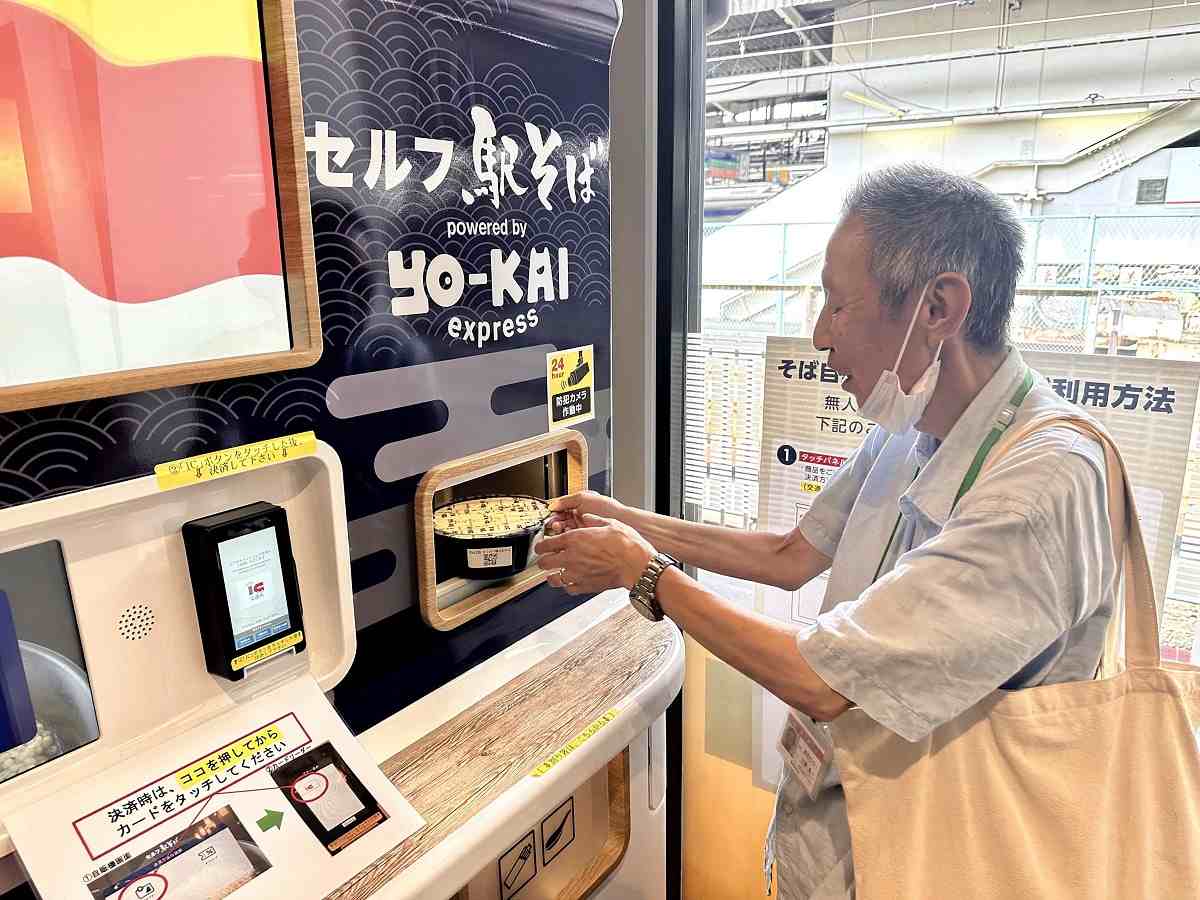Train Station Soba Shops Declining Yet Remain Popular; Evolving with New Technologies and Online Sales

Aiko Kagamoto, the owner of Kawamuraya soba shop in Yokohama, boils soba noodles on Sept. 1, the shop’s reopening day.
10:00 JST, October 19, 2023
Soba noodle stands on railway platforms, known colloquially as “ekisoba,” allow passengers to quickly stave off hunger while waiting for their train. While the number of ekisoba shops is said to be declining, they remain highly popular. This article explores the current status of Japan’s original fast food.
I visited Kawamuraya, a soba shop next to the ticket gates in JR Sakuragicho Station in Yokohama on the afternoon of Sept. 1, and found a line of people waiting to get in. I wanted to have chicken soba, but it had sold out. So, I ordered tempura soba instead. The aroma of soup containing a lot of natural dashi stimulated my appetite.
The long-established soba shop had closed in March this year due to reasons such as the aging of employees, but it reopened on the day. Back on the shop’s last business day in March, 1,800 customers had come to the shop to say goodbye. Aiko Kagamoto, 31, quit her company job and took over her father’s business. She said, “I realized that the shop has been loved by many people and decided to keep the place alive. I am determined to maintain the shop.”
According to writer Hiroki Suzuki, 49, author of “The 100 Best Ekisoba Shops in Japan,” there are about 3,000 station soba stands across the country, including those located within five minutes’ walk of a station. The number of ekisoba is declining for reasons such as the shortage of successors to run the shops, surging costs for ingredients and intensified competition caused by the diversification of restaurants at stations like ekinaka commercial areas within train stations. Last year, the soba stand on the Tokaido Shinkansen platform at Tokyo Station was shuttered.
Station noodle stands are said to date back to around 1900, during the Meiji era (1868-1912) when railway networks were built across Japan. The stands spread throughout the country because they allowed passengers to eat soba quickly at reasonable prices while waiting for locomotives to be exchanged.
“Each shop has its own characteristics, allowing customers to feel the local color of the city,” Suzuki said. “I guess many people are drawn to station soba noodles not only because they are cheap, quick and delicious but also because they are nostalgic and have an atmosphere that gives you a sense of travel.” Other reasons for the popularity of station soba noodles are “the experience” and “memories.”
There is an instance of a different company inheriting the taste of a closed soba shop. Kisoba noodle shop at JR Oyama Station in Tochigi Prefecture closed in January last year, but it was reopened by a local company, Shiga Sangyo, as Oyama no Kisoba soba shop near Ashikagashi Station in the prefecture in September last year. The company purchases its noodles from the same noodle factory to achieve the same taste. “I would like to keep alive the memory of eating soba there with my father,” a senior official of the company, Mitsuhiro Matsukawa, 50, said. Some fans have even visited the shop from Hokkaido and the Tohoku region to try the revived Kisoba noodles.
There are also railway soba sold online or by mail. The noodles in question are by a soba stand at Otoineppu Station in Hokkaido and were praised by railway enthusiasts as the most delicious railway soba in Japan, but the shop closed in February 2021 to the disappointment of fans. The noodle factory producing the unique black noodles served at the shop went out of business soon after the shop’s closure. Hiroshi Sato, 69, who is from the village of Otoineppu and runs the restaurant Otoineppu Shokudo in Mobara, Chiba Prefecture, has recreated the black color and smooth texture of the shop’s soba in cooperation with the restaurant Otoineppu Tokyo in Tokyo. It took him six months to get the green light from the former noodle factory. “I would like to use the noodles to help promote and revitalize the village,” he said.

The revived Otoineppu Station soba noodles, which features black noodles.
While the economic environment for railway soba is harsh, there is data providing a tailwind for the industry. According to a survey by the Hakuhodo Institute of Life and Living (HILL), the percentages of both men and women who are embarrassed by eating at tachigui-soba noodle bars are on a downtrend in recent years. Akemi Natsuyama, chief researcher at the HILL, said, “If added value is given to railway soba noodles based on current trends, new demand might be created.”
New technologies
Unmanned or labor-saving technologies have been introduced in station soba shops. In June, a “self-ekisoba” vending machine was introduced on the Joban Line platform at JR Ueno Station. A user can operate a panel and get hot soba out of the machine in about 90 seconds. An official of JR East Cross Station Co., a Tokyo-based company which operates the soba vending machine, said, “We intend to monitor its effectiveness in mitigating the shortage of workers, sales and other matters and use the data for future developments.”

A “self-ekisoba” soba noodle vending machine
Soba shops in five stations in Tokyo and Chiba Prefecture, including JR Gotanda Station, introduced a “soba robot” that automates the processes of boiling soba, washing the noodles with running water and placing them in cold water. When a customer pushes an order button on the ticket machine, the cooking starts, and shop staff put the cooked soba noodles on a bowl and serve it to the customer. This robot not only helps address the worker shortage but also stabilizes the quality of dishes. Tokyo-based Connected Robotics, which developed the soba robot, aims to introduce it in 30 soba shops in the Tokyo metropolitan area by 2026.
While researching this story, I ate a lot of station soba noodles. I felt the creativity and efforts of the various shops, which made me more interested in soba noodles. I would like to continue to enjoy this fast food specific to Japan.
"JN Specialities" POPULAR ARTICLE
-

The Japan News / Weekly Edition (12/12-12/18)
-

English-language Kabuki, Kyogen Entertain Audiences in Tokyo; Portland State University Professor Emeritus, Graduates Perform
-

Noodle Dining Shunsai / Rich Oyster Ramen to Savor at Odasaga; Experienced 68-year-old Owner Creates Numerous Ramen Varieties
-

The Japan News / Weekly Edition (12/5-12/11)
-

People Keep Loved Ones’ Ashes Close in Special Jewelry, Small Urns as Unique Way to Memorialize Them
JN ACCESS RANKING
-

Keidanren Chairman Yoshinobu Tsutsui Visits Kashiwazaki-Kariwa Nuclear Power Plant; Inspects New Emergency Safety System
-

Imports of Rare Earths from China Facing Delays, May Be Caused by Deterioration of Japan-China Relations
-

University of Tokyo Professor Discusses Japanese Economic Security in Interview Ahead of Forum
-

Tokyo Economic Security Forum to Hold Inaugural Meeting Amid Tense Global Environment
-

Japan Pulls out of Vietnam Nuclear Project, Complicating Hanoi’s Power Plans

























